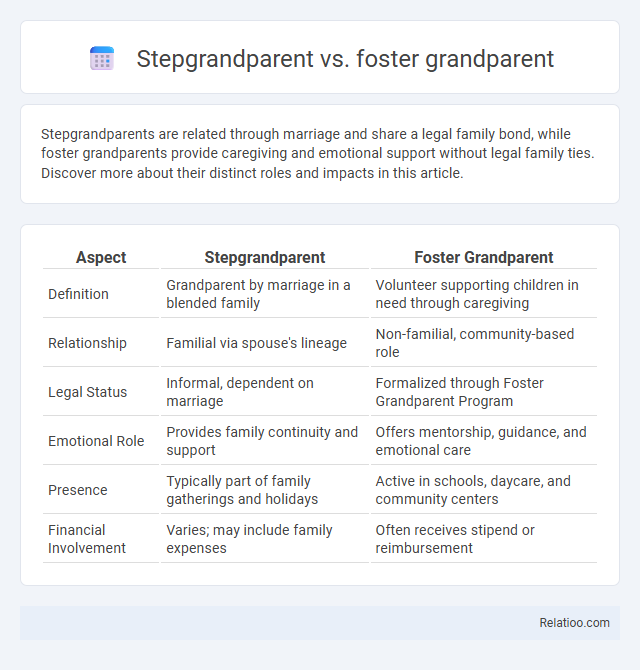Stepgrandparents are related through marriage and share a legal family bond, while foster grandparents provide caregiving and emotional support without legal family ties. Discover more about their distinct roles and impacts in this article.
Table of Comparison
| Aspect | Stepgrandparent | Foster Grandparent |
|---|---|---|
| Definition | Grandparent by marriage in a blended family | Volunteer supporting children in need through caregiving |
| Relationship | Familial via spouse's lineage | Non-familial, community-based role |
| Legal Status | Informal, dependent on marriage | Formalized through Foster Grandparent Program |
| Emotional Role | Provides family continuity and support | Offers mentorship, guidance, and emotional care |
| Presence | Typically part of family gatherings and holidays | Active in schools, daycare, and community centers |
| Financial Involvement | Varies; may include family expenses | Often receives stipend or reimbursement |
Understanding Stepgrandparents: Definition and Role
Stepgrandparents are individuals who become grandparents through marriage to a biological grandparent, creating a legally recognized familial bond without a direct blood relation. Their role often includes providing emotional support, guidance, and family cohesion, bridging relationships between stepchildren and grandchildren. Unlike foster grandparents, who offer care through formal programs, stepgrandparents' involvement stems from family dynamics rather than institutional arrangements.
Who Are Foster Grandparents? Meaning and Importance
Foster grandparents are volunteers aged 55 and older who provide mentorship, companionship, and support to children and youth in need, often through schools, childcare centers, or community programs. Their role is essential in promoting emotional stability, academic success, and social development for vulnerable children, complementing the support they receive from family and caregivers. Your involvement as a foster grandparent can create lasting positive impacts on a child's life by offering guidance and care unmatched by biological or stepgrandparents.
Legal Rights: Stepgrandparent vs Foster Grandparent
Stepgrandparents typically hold no automatic legal rights unless formalized through adoption or guardianship, whereas foster grandparents may have specific rights and responsibilities defined by foster care agreements and state laws. Your stepgrandparent's involvement in decisions about your well-being depends on legal recognition, while foster grandparents often work within regulatory frameworks protecting the child's welfare. Understanding these distinctions is crucial for navigating custody, visitation, and caregiving roles effectively.
Emotional Bonds: Building Relationships with Grandchildren
Stepgrandparents, foster grandparents, and biological grandparents each play distinct roles in building emotional bonds with grandchildren by providing love, support, and stability. Your ability to develop trust and meaningful connections depends on consistent presence, open communication, and respect for the child's family dynamics. Emotional bonds grow strongest when stepgrandparents and foster grandparents engage actively in the child's life, creating a sense of belonging and security.
Family Dynamics and Acceptance Challenges
Stepgrandparents often face complex family dynamics due to their roles being less defined legally and socially, which can lead to varied acceptance levels within blended families. Foster grandparents provide vital emotional and practical support, frequently navigating acceptance challenges tied to their temporary caregiving status and the child's biological family relations. Both stepgrandparents and foster grandparents must manage boundaries and build trust to foster meaningful relationships amid diverse family structures.
Parental Authority and Boundaries
Stepgrandparents typically hold no formal parental authority and navigate boundaries based on the relationship with their stepchild's parents and grandchildren. Foster grandparents, often part of formal foster care programs, may have limited legal authority and clear caregiving boundaries defined by child welfare agencies. Stepgrandparents' roles and limits vary widely, often shaped by family dynamics and legal frameworks, emphasizing respect for the primary parental authority.
Inheritance and Financial Responsibilities
Stepgrandparents typically do not have automatic inheritance rights unless specifically included in a will, while foster grandparents have no legal inheritance claims as their role is caregiving without familial ties. Financial responsibilities generally do not extend to stepgrandparents unless they have legally adopted or taken guardianship, whereas foster grandparents provide care without financial obligations. Your estate planning should clearly define the roles and inheritance intentions to avoid confusion among stepgrandparents and foster grandparents.
Cultural Perspectives on Step and Foster Grandparents
Cultural perspectives on stepgrandparents and foster grandparents vary significantly, influencing family dynamics and caregiving roles. In many cultures, stepgrandparents may face challenges in acceptance due to traditional views on bloodline kinship, whereas foster grandparents often gain respect for their supportive role in non-biological caregiving. Your understanding of these cultural nuances informs how relationships with step and foster grandparents are valued and integrated within diverse family structures.
Supporting Children’s Wellbeing: Guidance and Care
Stepgrandparents, foster grandparents, and adoptive grandparents each play vital roles in supporting children's wellbeing through tailored guidance and care. Stepgrandparents often provide continuity and family-rooted emotional support, helping children navigate blended family dynamics with stability. Foster grandparents, typically older volunteers, offer mentorship, emotional encouragement, and educational assistance, fostering resilience and social development in vulnerable children.
Navigating Conflicts: Tips for Harmonious Relationships
Navigating conflicts between stepgrandparents, foster grandparents, and biological grandparents requires clear communication and respect for each role's unique contributions to Your family's dynamics. Establishing boundaries, acknowledging each grandparent's emotional investment, and fostering mutual understanding can prevent misunderstandings and strengthen relationships. Prioritizing empathy and open dialogue helps create a supportive environment where all grandparents feel valued and connected.

Infographic: Stepgrandparent vs Foster Grandparent
 relatioo.com
relatioo.com